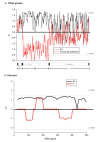Identification of super-infected Aedes triseriatus mosquitoes collected as eggs from the field and partial characterization of the infecting La Crosse viruses
- PMID: 20412589
- PMCID: PMC2873378
- DOI: 10.1186/1743-422X-7-76
Identification of super-infected Aedes triseriatus mosquitoes collected as eggs from the field and partial characterization of the infecting La Crosse viruses
Abstract
Background: La Crosse virus (LACV) is a pathogenic arbovirus that is transovarially transmitted by Aedes triseriatus mosquitoes and overwinters in diapausing eggs. However, previous models predicted transovarial transmission (TOT) to be insufficient to maintain LACV in nature.
Results: To investigate this issue, we reared mosquitoes from field-collected eggs and assayed adults individually for LACV antigen, viral RNA by RT-PCR, and infectious virus. The mosquitoes had three distinct infection phenotypes: 1) super infected (SI+) mosquitoes contained infectious virus, large accumulations of viral antigen and RNA and comprised 17 of 17,825 (0.09%) of assayed mosquitoes, 2) infected mosquitoes (I+) contained no detectable infectious virus, lesser amounts of viral antigen and RNA, and comprised 3.7% of mosquitoes, and 3) non-infected mosquitoes (I-) contained no detectable viral antigen, RNA, or infectious virus and comprised 96.21% of mosquitoes. SI+ mosquitoes were recovered in consecutive years at one field site, suggesting that lineages of TOT stably-infected and geographically isolated Ae. triseriatus exist in nature. Analyses of LACV genomes showed that SI+ isolates are not monophyletic nor phylogenetically distinct and that synonymous substitution rates exceed replacement rates in all genes and isolates. Analysis of singleton versus shared mutations (Fu and Li's F*) revealed that the SI+ LACV M segment, with a large and significant excess of intermediate-frequency alleles, evolves through disruptive selection that maintains SI+ alleles at higher frequencies than the average mutation rate. A QTN in the LACV NSm gene was detected in SI+ mosquitoes, but not in I+ mosquitoes. Four amino acid changes were detected in the LACV NSm gene from SI+ but not I+ mosquitoes from one site, and may condition vector super infection. In contrast to NSm, the NSs sequences of LACV from SI+ and I+ mosquitoes were identical.
Conclusions: SI+ mosquitoes may represent stabilized infections of Ae. triseriatus mosquitoes, which could maintain LACV in nature. A gene-for-gene interaction involving the viral NSm gene and a vector innate immune response gene may condition stabilized infection.
Figures









References
-
- Reimann CA, Hayes EB, DiGuiseppi C, Hoffman R, Lehman JA, Lindsey NP, Campbell GL, Fischer M. Epidemiology of neuroinvasive arboviral disease in the United States, 1999-2007. American Journal of Tropical Medicine and Hygiene. 2008;79:974–979. - PubMed
-
- Pantuwatana S, Thompson WH, Watts DM, Yuill TM, Hanson RP. Isolation of La Crosse virus from field collected Aedes triseriatus larvae. American Journal of Tropical Medicine and Hygiene. 1974;23:246–250. - PubMed
-
- Watts DM, Thompson WH, Yuill TM, DeFoliart GR, Hanson RP. Overwintering of La Crosse virus in Aedes triseriatus. American Journal of Tropical Medicine and Hygiene. 1974;23:694–700. - PubMed
-
- Beaty BJ, Thompson WH. Emergence of La Crosse virus from endemic foci. American Journal of Tropical Medicine and Hygiene. 1975;24:685–690. - PubMed
Publication types
MeSH terms
Substances
Associated data
- Actions
- Actions
- Actions
- Actions
- Actions
- Actions
- Actions
- Actions
- Actions
- Actions
- Actions
- Actions
- Actions
- Actions
- Actions
- Actions
- Actions
- Actions
- Actions
- Actions
- Actions
- Actions
- Actions
- Actions
- Actions
- Actions
- Actions
- Actions
- Actions
- Actions
- Actions
- Actions
- Actions
- Actions
- Actions
- Actions
- Actions
- Actions
- Actions
- Actions
- Actions
- Actions
- Actions
- Actions
- Actions
- Actions
- Actions
- Actions
- Actions
- Actions
- Actions
- Actions
- Actions
- Actions
Grants and funding
LinkOut - more resources
Full Text Sources
Molecular Biology Databases

